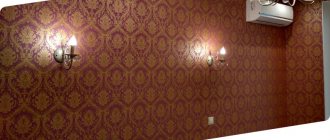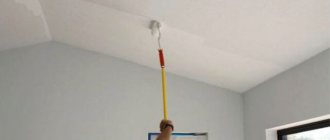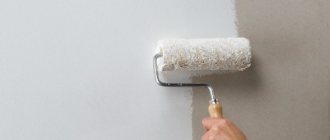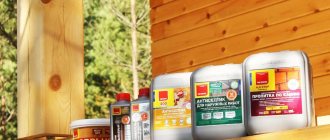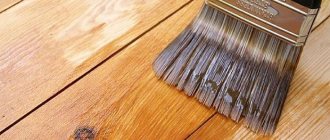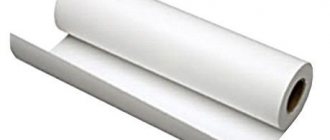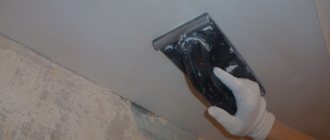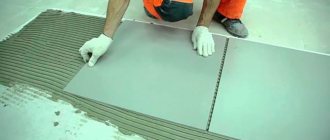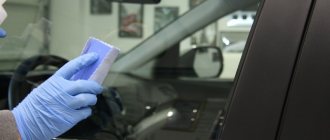From time to time it is necessary to carry out repair work in any room. And the ceiling becomes the face of the room, because the overall impression of the room will depend on its appearance. Most modern paints are marked that it does not need to be pre-treated before applying to the ceiling. Before you begin repair work, you need to understand why you need a primer for the ceiling.
Purpose and application
Priming the ceiling before painting is an important part of the painting job. The fact is that the main purpose of the material is to reduce moisture absorption of the surface. The layer prevents the ceiling from absorbing moisture from the paint, and it will dry in an even layer. When applying paintwork to an untreated surface, the paint will dry out and may become cracked. Uneven drying is also possible.
The material is mainly used to improve the adhesion of paint to the ceiling surface. When applying the primer material to a plane, it forms a rough film, which improves adhesion to the paint and also prevents moisture from being absorbed from the paint material. In addition, pre-treatment before painting can hide small defects on the ceiling, such as cracks and small differences in height.
The primer performs many functions:
- Strengthening the surface, in particular preventing the ceiling from falling off;
- Strengthening the base for painting;
- Improves the water-repellent properties of the ceiling;
- Improves the adhesion of the ceiling to paint and other finishing materials;
- Makes subsequent putty (plaster) easier and smoother;
- Protects the surface from mold formation;
- Helps reduce paint costs for subsequent finishing;
- Promotes rapid hardening of the putty;
- Increases the service life of subsequent finishing (paint, wallpaper, tiles, etc.).
The universal option can be used on almost any plane. In particular, its use on various materials makes it universal.
Composition and technical characteristics
The composition of ceiling primers includes the following components:
- Surface film forming agents;
- Plasticizer;
- Additives to improve film formation;
- Antiseptics;
- Components to improve absorption and hardening.
In addition, color pigments may be present in the primer composition. The shade of the coating will depend on their addition.
Important! The composition of the primer may vary depending on the intended surface to be coated, as well as the type of room.
A universal ceiling primer for painting dries on average in 1-1.5 hours. Can be stored for up to 6 months at temperatures from 5 to 50 degrees. Retains its properties at temperatures of 5-30 degrees.
Consumption per 1 m2
Basically, when applying 1 layer, 10 liters of primer material is enough for 65 sq.m. The average consumption is 0.15-0.17 kg/sq.m.
This indicator can increase upward depending on the type of surface, porosity and smoothness. Also, consumption increases with the number of layers applied.
Wall treatment
To extend the life of painted walls, they must first be primed.
In this case, a composition that has a high binding effect is ideal. As a result, the paint will be less absorbed into the wall, which will save the consumption of materials.
But you should take into account the fact that if the wall has an uneven surface, then you must first apply a primer with deep penetration. It will saturate and level, thereby prolonging its service life.
Priming the walls is also necessary in order to provide them with antibacterial protection. Just like ceilings, walls should be treated with an antiseptic compound (if there is fungus in the room).
In addition to priming, before applying water-based paint to the surface, it must also be plastered.
Tips and recommendations for use
To make high-quality painting of the ceiling, you must follow the instructions for use. Basically, the work of preparing the surface and applying the primer is divided into stages:
- First of all, it is necessary to vacate the premises in which repair work will be carried out. Remove all lighting fixtures from the ceiling, if any. It is recommended to lay a film on the floor.
- It is imperative to remove the old coating from the plane and clean the ceiling. Whitewash is easily removed with a wet roller and scraper. Paint can be removed with sandpaper and solvent.
Important! Before starting work, the room must be de-energized!
- After cleaning, you need to check the ceiling for cracks and irregularities. All of them are covered with putty.
- After which you can start working with the primer composition. It is important to follow the instructions when diluting the primer with water. Otherwise, insufficient or excessive amounts of liquid will negatively affect the quality of the coating.
- The substance can be applied using a roller and brush. You should not give preference to only one of their options. With a brush you can reach hard-to-reach places, and with a roller you can level the surface. So it’s worth purchasing both tools in advance.
- The primer must be applied in two layers. It is important to wait for the first coat to dry before applying the second. It is also recommended that the direction of layering be perpendicular.
- After which it is recommended to apply two layers of putty. It is also worth treating each layer with a primer. This will make the ceiling much smoother and stronger.
Advice! To prevent streaks from the layers from being visible after painting, it is recommended to finish with a roller. You can also replace it with a spray gun when applying the second layer. In this case, the layer will lie very evenly, without stripes or bald spots.
After all this work, you can safely apply paint. Preliminary priming and putty will reduce paint consumption.
Can oil paint be coated with water-based emulsion?
Water-based emulsion is a high-quality, harmless dye that allows you to paint walls/ceilings in any shade. It is also worth noting that with this type of paint coating you can also hide cracks whose depth is no more than 1 mm. This composition is easily diluted with water, and the materials used for painting are easily washed. However, you should not be afraid that the painted wall or ceiling will be washed off when wiping the dust with a damp cloth. But doubts arise as to whether the water-based emulsion will work on oil-based paint. This is due to the fact that when the paint composition dries, it partially loses moisture. On the oil layer of the previous coating, the outer layer does not allow absorption, which leads to runoff or peeling. The walls of commercial and residential premises can be repainted with such compositions, since they are environmentally friendly and also wash well. If the surface was previously painted with oil paint, which adheres well, then you can apply a new layer over it, taking into account the recommendations below. If the previous finishing material adheres firmly enough to the surface, it can be left. But at the same time it is necessary to comply with certain preparation conditions. Otherwise, after a few weeks the new coating will begin to wear off/crumble. It is also worth noting that this type of painting should only be done if the surface is not subject to intensive use. Although it is technically acceptable to apply water-based emulsion to oil-based paint, finishers tend to strip everything completely. This will allow you to avoid possible difficulties or incidents in the future, as well as perform high-quality coloring in the specified colors. The only drawback of using this approach is to indicate only the larger time and economic costs, so when doing repairs yourself, this method is rarely used. In order for the water-based emulsion to adhere well to the surface to be painted, it must be soaked. But the old oil coating almost does not allow moisture to pass through. Accordingly, the application will be uneven. In worn or scratched areas it will be absorbed more, and where it is not possible to completely clean everything, the new layer may completely slide off.
Removing the old layer
Advantages and disadvantages
Ceiling primer for painting has its clear advantages:
- Levels the plane;
- Improves adhesion to paint;
- The application process is very simple;
- Protects from moisture;
- A large palette of colors makes the painting process easier;
- Protects the ceiling from mold and mildew, and prevents corrosion when processing metal parts.
But despite many advantages, the material also has its disadvantages:
- Layer transparency;
- Possibility that the film is formed unevenly.
But almost all shortcomings can be easily solved by correctly applying the material to the ceiling.
Conclusion
Now you know what primers and how to properly treat walls before painting with water-based emulsion. Additionally, watch the video in this article. If you have any questions about the above topic, please contact me in the comments, and I will be happy to answer you.
Did you like the article? Subscribe to our Yandex.Zen channel
June 20, 2022
Paint, Construction Chemicals
If you want to express gratitude, add a clarification or objection, or ask the author something, add a comment or say thank you!
Types of primers for ceilings
There are several types of primer, and in order to make high-quality repairs, it is necessary to select the material for priming strictly for the type of subsequent finishing. Also, the material must be selected in accordance with the type of surface on which it will be applied.
Thus, the primer is divided into the following types:
- Acrylic.
It contains acrylic polymers. Can be applied to wood, brick, concrete, fiberglass, cement and plaster surfaces. This primer is water-based and recommended for use before painting with water-based materials.
Important! In residential areas, acrylic, mineral or alkyd based primers can be used.
- Alkyd.
This primer is different from other high strength primers. Mainly used on surfaces made of tiles, glass and steel. This primer is not suitable for use on plaster or drywall.
- Mineral.
This type is the most popular and widespread. It can be used on brick, concrete, plaster, aerated concrete and foam concrete surfaces. The composition is based on cement, gypsum and lime.
- Colorful.
To produce this type, drying oil or resin is used. Used for subsequent painting of wooden or metal ceilings. There are also options with additional anti-corrosion and moisture-resistant properties.
- Deep penetration primer.
This type of primer penetrates the surface to a distance of 0.3-2 cm. This thereby strengthens the ceiling. There are also options with antiseptic properties that prevent the occurrence of rot, mold and mildew.
- Quartz.
This primer contains sand. After the material dries, the ceiling plane becomes very rough. Used for application to ceilings and other surfaces for painting and other finishing materials.
There are options that are full coverage. They are usually applied in several layers.
Preparation for painting
Traditional option
What operations should precede painting a base covered with old paint?
- Cleaning the paintwork.
- Puttying to eliminate minor defects.
- Grinding a surface to make it rough.
- Application of primer selected for the type of surface and composition of the new paint.
However, in some cases, removing old paint is problematic.
The list of possible reasons is quite extensive:
- Limited resistance of the base to washes.
- Insignificant heat resistance, which does not allow using a hair dryer to soften the old coating.
- Low mechanical strength of the base, which does not allow old paint to be removed with a spatula or sanding.
- Finally, just a larger surface area to paint. Imagine that you have to paint a hundred or two square meters of surface alone. Here you can’t help but think: is it worth spending several days, or even weeks of work on cleaning it?
Priming on paint
Fortunately, thanks to modern primer compositions, you can make your life much easier.
Primer over old paint is quite possible if several conditions are met:
- The coating is not glossy. If so, you will still have to spend time rough sanding it.
- Old paint does not peel off. Where its layer comes off, it must be cleaned.
Primers for old paints are versatile: they become an intermediate layer between the old and new coatings, having equally high adhesion to both of them.
Review of popular manufacturers
Among the popular manufacturers of primer material are:
- Prospectors.
The primer from this manufacturer fills any cracks and pores in the surface. Quartz sand in the composition significantly improves the adhesive properties of the surface. Primer consumption is 0.1 l/sq.m. The layer dries in 1 hour.
- Ceresite.
The composition of this material is based on synthetic resin. The primer is well absorbed and is also protected from uneven drying.
- Optimist.
The primer from this manufacturer is used for surface treatment indoors and outdoors. The composition contains quartz sand and antiseptics. Suitable for application on surfaces that are subject to constant humidity.
- Bolars.
The primer is transparent or matte, usually white. Used to strengthen concrete plasterboard. Helps reduce the amount of paint up to 1.5 times.
- Text.
A universal primer that penetrates 6 mm into surface pores. Used to prepare surfaces indoors and outdoors. Can be used in damp environments.
Need to read the label
Make it a habit to read the instructions on the label. After all, it contains all the technical characteristics.
- In the annotation you will find what types of work this emulsion is intended for.
- Also there you will find the emulsion consumption per square meter. This is necessary to calculate the required quantity.
- The degree of coverage will also be indicated there - this is the ability or ability of the water emulsion to cover a darker background.
- And finally, the abrasion resistance of the water-based emulsion should be indicated in the annotation.
Pay special attention to the small font in the annotation, because... the manufacturer often enters the main technical characteristics there.
- It is recommended to use the emulsion in dry rooms. Such an inscription notifies the consumer that this paint is not suitable for painting the ceiling in the kitchen. Since in the first case there will be constant oily evaporation, and in the second case there will be increased humidity.
- Leave-in emulsion or highly durable. This means that the ceiling can be washed without the use of cleaning agents and detergents.
- The paint is abrasion resistant. Dirt-repellent property. This surface can be cleaned with detergents.

